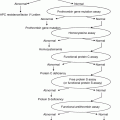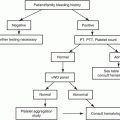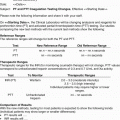Fig. 8.1
Generation of cross-linked fibrin by thrombin and factor XIIIa following activation of coagulation, and consequences of plasmin degradation of cross-linked fibrin. (a) Following activation of coagulation, thrombin activates the transglutaminase, factor XIII to factor XIIIa, and cleaves fibrinopeptides A and B from fibrinogen to generate fibrin monomers. (b) Fibrin monomers align longitudinally and with adjacent monomers to form fibrin polymers. (c) Factor XIIIa cross-links the D-domains of fibrin monomers to form rigid fibrin polymers. (d) Plasminogen activators (TPA or UK) convert plasminogen to plasmin; plasmin degrades cross-linked fibrin to fibrin degradation products, including fragment D, fragment E, and D-dimer, in addition to other products
8.3 Antibodies to Coagulation Factors
Rarely, patients with previously-normal hemostasis who develop prolonged PT and/or PTT assays and bleeding will not have either vitamin K deficiency or DIC. These patients will probably have acquired antibodies against a clotting factor, usually factor VIII or factor V [1]. The appropriate evaluation is to first perform mixing studies (see Chap. 5) to determine if an inhibitor (antibody) is present. Next, specific factor assays confirm the affected factor. Thus, for a patient with previously-normal PT and PTT values who develops bleeding with an isolated, prolonged PTT, failure to correct the prolonged PTT with a mixing study, followed by assay of factors VIII, IX, XI would diagnose this patient’s acquired bleeding disorder. Antibodies to factor VIII are the most commonly seen.
For patients who have acquired prolonged PT and PTT values, performing mixing studies with both the PT and PTT assays is indicated, followed by assay of common pathway coagulation proteins—fibrinogen, prothrombin, factor V, and factor X. Of these clotting factors, antibodies to factor V are most commonly seen.
In addition to antibody inhibitors, heparin-like inhibitors may occasionally be seen, causing coagulopathy and bleeding in patients with malignant disease. Heparin-like inhibitors are suspected in bleeding patients who have prolonged PTT values that do not correct with mixing, normal PT values, markedly prolonged thrombin time values, normal reptilase assays, and positive results for heparin using an anti-factor Xa assay.
8.4 Abnormal Fibrinolysis
Abnormal fibrinolysis is an uncommon bleeding disorder in which excessive plasmin is generated. Plasmin is appropriately generated following initiation of coagulation and thrombin formation (secondary fibrinolysis). For example, patients with DIC have secondary fibrinolysis which is appropriate. In contrast, in abnormal or primary fibrinolysis, there is no laboratory evidence for thrombin formation (negative D-dimer). Examples of clinical conditions associated with abnormal fibrinolysis include inherited α2-antiplasmin deficiency, tumors of the genito-urinary tract, gynecologic tumors, acute promyelocytic leukemia, liver disease, and fibrinolytic drugs [1].
Stay updated, free articles. Join our Telegram channel

Full access? Get Clinical Tree






